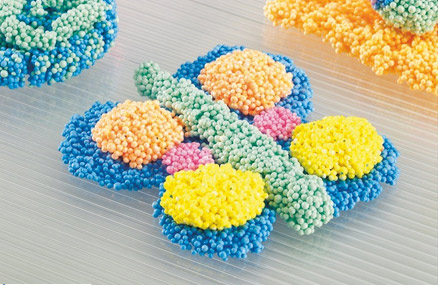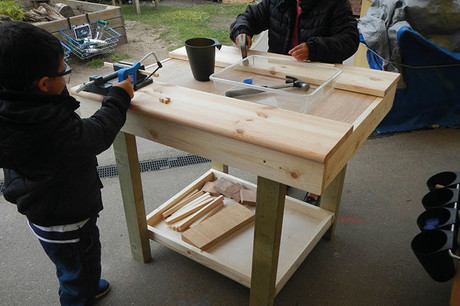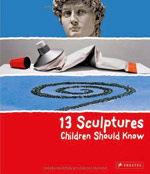
Sculpture is a three-dimensional visual art form that offers children the opportunity to explore, and work creatively with, a range of materials, both indoors and out. Sculptures can be created out of wood, clay, recycled materials, paper, sand or even ice.
Early years and creative arts consultant Anni McTavish says, ‘Sculpture, as well as other art forms, gives children the opportunity to represent ideas, thoughts, feelings and experiences. It allows them to invent, problem-solve, collaborate and explore other areas of learning – finding out about shape, measurement and calculation as they explore materials and work out how to join and build things together. Children are also developing their knowledge and understanding of the world as they explore different objects and raw materials.’
Practitioners can help stimulate ideas for sculpture and develop children’s awareness of form and shape by surrounding them with interesting 3D objects, both large and small.
PRACTITIONER ROLE
‘It can be a little daunting to come up with ways to support and create sculpture in our settings, unless we have a particular interest in it, or we’re fortunate to have had some arts training or mentoring from colleagues,’ Ms McTavish explains.
‘It also depends on our personal experience of making and working with sculpture, and how much we’ve had the chance to go and see and feel different sculpture in galleries, parks or public spaces.’
One way to support practitioner confidence is by working with resident artists. Pembury House Nursery School in Tottenham, north London, has a part-time artist, funded through the Early Years Pupil Premium, to support the whole arts curriculum, particularly sculpture and photography (see Case Study).
Head teacher Sue Moss explains, ‘Practitioners are more willing to experiment and have a go with different materials, and this in turn encourages children to do the same.
‘Practitioners might do any number of things, such as providing a provocation – for example, last week it was all about boxes and beautiful coloured tape, because children had been interested in junk-modelling and connecting things together.
‘Practitioners also support learning by modelling, such as how to use tools and materials appropriately, by offering encouragement and support for children’s ideas and questions. The children recently asked lots of questions about the actual word “sculpture”. One child misheard the word and asked, “What is a squelch?” This is a good reminder that it’s important to use the correct language, and take time to talk about things, and share examples with children.’
ENABLING ENVIRONMENTS
- Activities that support 3D art, in the form of sculpture, should be offered inside and out. The outdoors enables children to work on a much larger scale and provides valuable experiences to develop their understanding of length, width and depth. Essential resources for your continuous provision include:
- a selection of loose parts – free-and-found, mainly natural materials to use outdoors and in to create 3D art
- a set of good-quality wooden blocks such as Community Playthings’ Large Hollow Blocks and smaller unit blocks
- a variety of malleable materials – clay, play dough, Plasticine, etc
- junk-modelling resources – tubes, boxes and containers of all shapes and sizes
- paper, card, fabric, silver foil, buttons, wire and interesting found materials, along with fastenings, such as glue and tape
- materials to create hanging sculptures – for example, by tying and threading materials such as strips of wood, shells, beads and leaves onto string or wool
- mud and sand
- a variety of tubes (socks, stockings, net tubes) for the children to fill with a material (newspaper, fabric, foam, wool) to create 3D forms; children can use these in imaginative play activities
- outdoors – bamboo poles, guttering, milk crates, large cardboard boxes and access to fallen branches
- books about sculpture to inspire adults and children
- provocations to spark curiosity, including real sculptures; natural objects; interesting objects such as masks and candlesticks; patterns in nature and items connected to children’s interests. Provide photos or postcards and pop-up books, which are also good examples of paper sculpture
- taking children on trips to museums, galleries or examples of public art in parks, squares or other parts of the community
- visiting a local artist or looking at YouTube videos or images of sculpture online. Alternatively, arrange a visit to a setting that has developed its practice in promoting early years arts.
CASE STUDY
Children at Pembury House Nursery School in Tottenham, north London, have been creating a variety of sculptures. This has ranged from small-scale work with clay, buttons and beads to large-scale installations using wire and found objects, and chunky wooden pieces decorated with jewels, metals and paint.
 ‘Hanging ice sculptures are a favourite,’ explains head teacher Sue Moss. ‘We decided to make them following children’s interest in the different plants that are thriving in the garden at the moment. The children mixed coloured water using food colouring and then went on a leaf and petal hunt. We gathered all sorts of leaves and mixed them with the coloured water in different-shaped containers. The children carried these carefully to the kitchen, and we put them in our freezer overnight. They look beautiful all hung outside.
‘Hanging ice sculptures are a favourite,’ explains head teacher Sue Moss. ‘We decided to make them following children’s interest in the different plants that are thriving in the garden at the moment. The children mixed coloured water using food colouring and then went on a leaf and petal hunt. We gathered all sorts of leaves and mixed them with the coloured water in different-shaped containers. The children carried these carefully to the kitchen, and we put them in our freezer overnight. They look beautiful all hung outside.
‘We took photographs so we can share the process with families, as this is something that could easily be done at home over the summer. The children were really involved in this, concentrating and persevering to get their mixtures just right. The transformation element has also been very exciting – sparking curiosity and scientific conversation as the children watched the sculptures melt in the sunshine.’
After a visit to Tate Modern, the children came back inspired and fascinated by some of the sculptures they had seen. Out of this visit grew the cardboard box sculpture.
Ms Moss says, ‘Children became interested in junk-modelling and using small tools and tape to join things together. So we provided them with boxes of different sizes, paint and rolls of coloured tape. Some chose to paint their boxes first and wait for them to dry before joining them together to create their sculptures. A wonderful conversation began about what sorts of animals their sculptures reminded them of… “I’ve got a cat called Otto, and he’s a bit greedy”… “It can be really big, and it can have feathers like an owl”.
‘The practitioner suggested they might like to put all their smaller sculptures together to create one giant sculpture. The children really enjoyed the collaborative element of this idea. It involved negotiating, problem-solving and helping each other out. Other children were drawn into the excitement. It meant they were able to work together, but also individually. One child brought a small metal container to the table, and invented a handle to carry it, using the coloured tape.
‘Exploring sculpture in all its many forms has really broadened our arts curriculum, and there is still so much more to try and find out about. It has enriched all areas of learning, as well as creating beautiful pieces of art for the setting.’
RESOURCES: BEST BUYS
Shape It (assorted colours) mouldable sand, £14.99 for 2.7kg; Kinetic Sand, £19.99 for 2.5kg; and Soff-Fun modelling materials, £14.99, all available from www.reflectionsonlearning.co.uk
 Maxi pack of ultra soft clay, £51.10; Modelling Clay School Pack, 7x500g blocks, £11.70; Playfoam Sensitive Playdough, £41.70; Ultra Soft Plasticine, £17.80; Silk Clay Modelling Clay, £8.70; and Fimo Soft School Pack, £27.70, from https://www.wesco-eshop.co.uk
Maxi pack of ultra soft clay, £51.10; Modelling Clay School Pack, 7x500g blocks, £11.70; Playfoam Sensitive Playdough, £41.70; Ultra Soft Plasticine, £17.80; Silk Clay Modelling Clay, £8.70; and Fimo Soft School Pack, £27.70, from https://www.wesco-eshop.co.uk
Card Tubes and Cones Pack of 30, £10.95; Card Panels Pack, £14.95; Giant Polydron XL Set, £63.95, from www.earlyyearsresources.co.uk
Eco building logs, £74.99; Nature building blocks, £22.49; Giant hollow blocks, £389.95; Building block cart, £225; Wooden cotton reels, £11.79; Woodwork bench, £229.00; Hammering/Tinkering block, £9.99; Real woodworkers starter kit, £27.99, from www.cosydirect.co.uk

Alto stackable buckets, £12.99; Bricklayer set, £4.99; Translucent Pipebuilders, £29.99; Creative Connectors, £34.99; and Shape A-Maze, £32.99, from www.reflectionsonlearning.co.uk

Willow Animal Sculptures, £209.95, from www.tts-group.co.uk
Extra Large Papier Mâché Tree, £179; Construct-O-Straws, £9.49; and Young Builders Set, £122.65, from www.ypo.co.uk
MORE INFORMATION
The Art Book for Children by Phaidon Editors
13 Sculptures Children Should Know by Angela Wenzel









